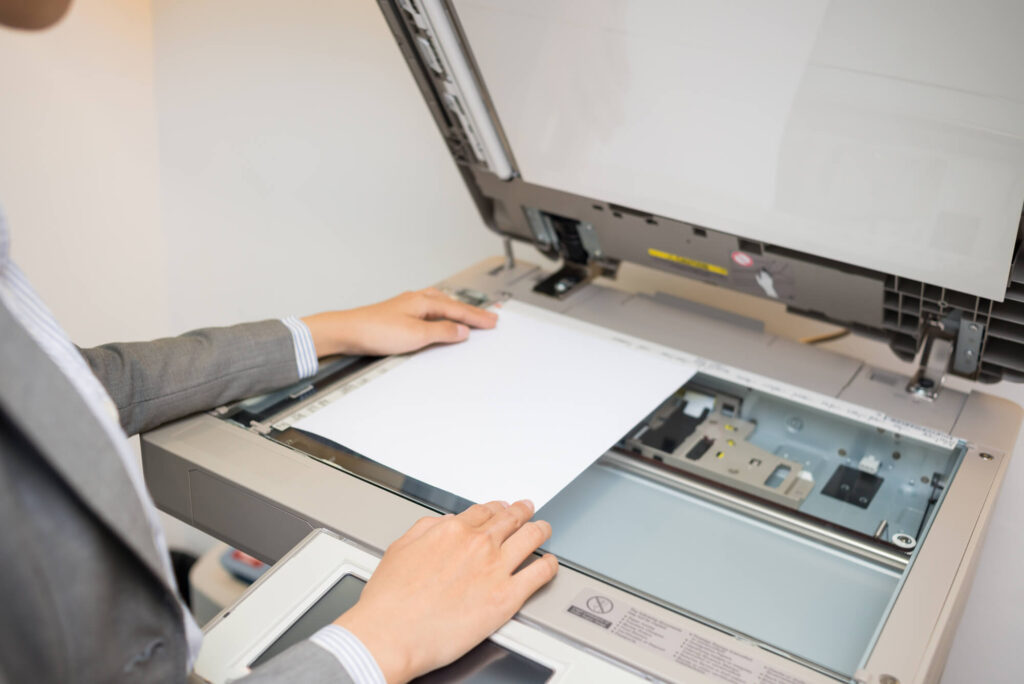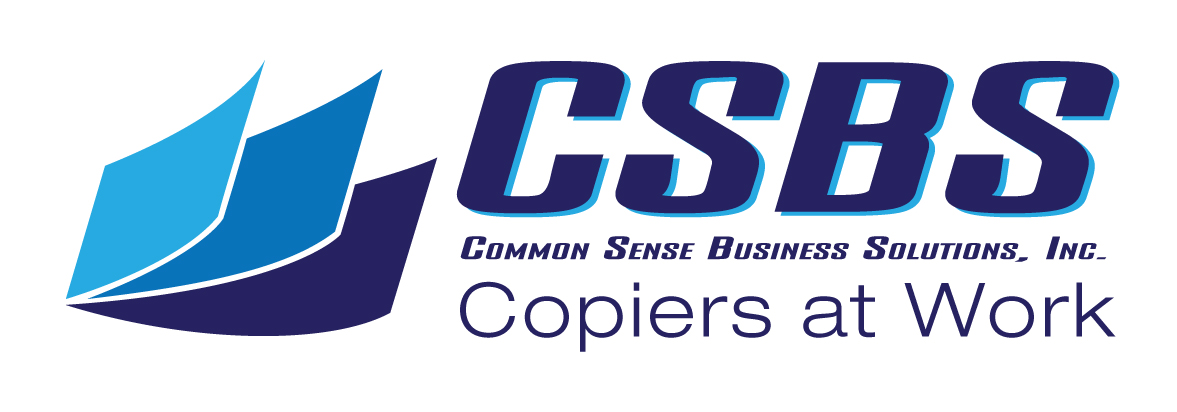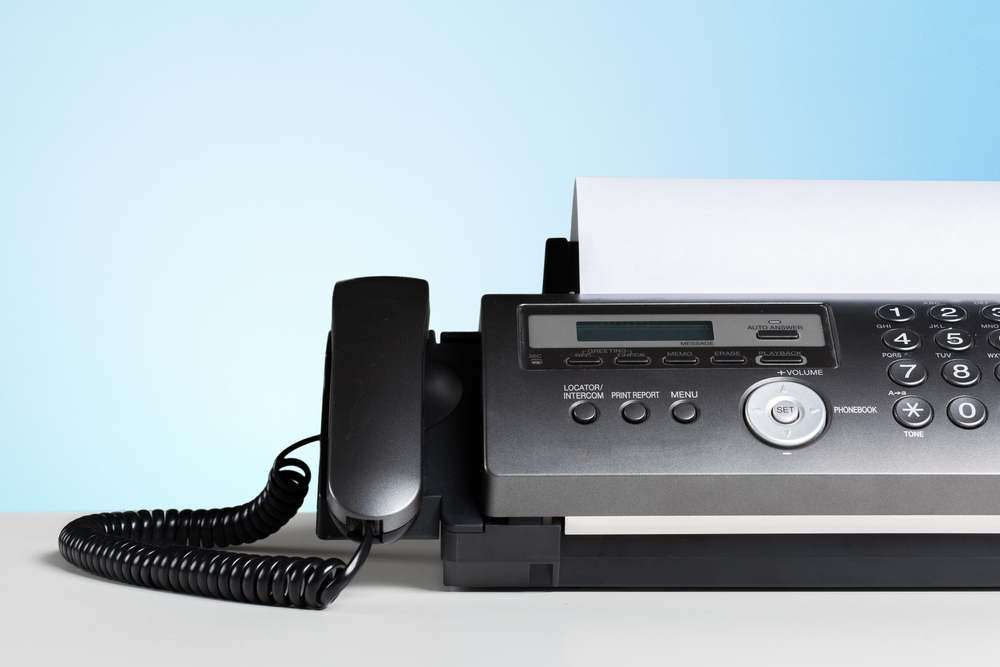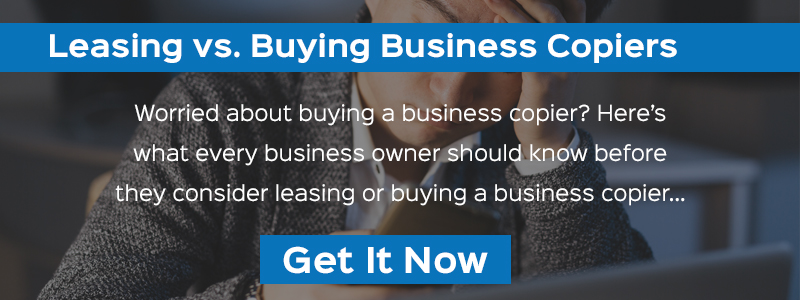A common question for those looking to buy a printer/fax/scanner/copier is whether they really need or will ever use the faxing functions.
This is a fair question as fax technology and fax machines are seemingly ancient in technology years!
However, even in the 21st Century, FAX technology is still very much alive.
Law-enforcement agencies remain heavily reliant on fax for routine operations, such as bail postings and return of public-records requests. Health care, too, runs largely on fax. Despite attempts to replace it, a mix of regulatory confusion, digital-security concerns, and stubbornness has kept fax machines in operation.
The Origins of Facsimile Automatic Xerox (FAX)
One source states that the acronym “fax” stands for “Facsimile Automatic Xerox.” although this appears to be debatable as others state that it is simply a contraction of the term “facsimile.”
Regardless of the origin of the word, the venerable fax machine has been with us longer than most people realize. In fact, the first known fax technology was developed over 150 years ago.
According to one article,
“The first fax machine was invented by Scottish mechanic and inventor Alexander Bain. In 1843, Alexander Bain received a British patent for “improvements in producing and regulating electric currents and improvements in timepieces and in electric printing and signal telegraphs…’”
Shortly after that, English physicist Frederick Bakewell obtained a patent for his “image telegraph” in 1848, which was an improvement over Bain’s invention.
However, both Bain’s and Bakewell’s devices reproduced poor quality images and were not viable systems due to their inability to fully synchronize the transmitter and receiver.
It wasn’t until 1861 that the first practical operating “telefax” machine was realized when the Pantelegraph was invented by the Italian physicist Giovanni Caselli.
“In an age of instantaneous information and images, it is hard to appreciate the magic that millions in the 1930s experienced upon seeing photographs of distant disasters appear the next day in their newspapers, or the excitement in the 1980s of watching an exact copy of a letter emerge line by line from a machine connected to the telephone network,” Jonathan Coopersmith writes in his book Faxed: The Rise and Fall of the Fax Machine.
He also introduced the first commercial telefax service that was set up between Paris and Lyon in 1865, at least 11 years before the invention of workable telephones.
It wasn’t until 1964, almost 100 years later, that the Xerox Corporation introduced the first commercial version of the modern fax machine, or LDX (Long Distance Xerography).
An entry at Wikipedia notes,
“In 1966, Xerox released the Magnafax Telecopiers, a smaller, 46-pound facsimile machine. This unit was far easier to operate and could be connected to any standard telephone line. This machine was capable of transmitting a letter-sized document in about six minutes. The first sub-minute, digital fax machine was developed by Dacom, which built on digital data compression technology originally developed at Lockheed for satellite communication.”

Xerox, along with its competitors, continued to refine the fax machine for years after their ground-breaking first machine.
Eventually, fax technology would be combined with copier equipment to create the hybrid or all-in-one machines we have today that print, copy, scan, and fax.
What is the World’s Current FAX Usage?
In the corporate world, most freestanding fax machines have been replaced by fax servers and other computerized systems such as printer/fax/scanner/copier devices that are capable of receiving and storing incoming faxes electronically.
These transmissions can then be delivered to recipients as hard copies or as an email.
These systems provide reduced costs for businesses by eliminating unnecessary printouts and reducing the number of inbound analog phone lines required in a workspace.
The large and unwieldy fax machine has also largely disappeared from small offices and home offices, as well.
Remotely-hosted fax-server services are widely available from VoIP and email providers, which allows users to send and receive faxes using their existing email accounts.
This eliminates the need for dedicated hardware or fax lines.
In addition, personal computers have been utilized for faxing using analog modems or ISDN, eliminating the need for stand-alone fax machines.
However, despite the changes in technology and the seemingly diminished need for faxing, there are still millions of fax users throughout the U.S. and even more in other countries.
Doctors rely heavily on faxes in both routine and high-stakes situations. According to Vox, one industry analyst estimates that 75 percent of all medical communications still happen by FAX.
This is partly due to an interpretation of a clause in HIPAA, a U.S. health-privacy law, which requires health providers to take reasonable steps to safeguard patient information. Because this rule explicitly mentions FAX and not email, some providers interpret the law to mean that records must go by FAX.
Lee Kim, Director of the Healthcare Information and Management Systems Society, “a document which is being sent via fax is difficult to intercept if sent over an analog telephone line, as this requires special equipment. On the other hand, an unencrypted email may be easier to intercept in transit by eavesdropping on the network.” So doctors have stuck with faxing.
And the practical advantages of fax technology contribute to its continuous usage. For example:
- In many instances, it’s still quicker than other technology
- It’s an easy way to send and receive signatures
- It provides confirmation of document receipt and confirmation pages
There are still many reasons to believe that the FAX is not going away any time soon:
- “The Network Effect” – Because lots of other people are still using it
- It integrates well with almost all other communication technologies
- You can isolate it from the Internet for security
- Confirmation page (Proof of receipt) is still vital in both legal and business
- It can be quicker than scanning, compiling, and emailing
- It is a common interface across boundaries, languages, or computer systems
- Japanese, Korean, and Chinese characters are easier to write out by hand
- Signature transmission (outside of a digital network) is valuable
- Every FAX gets seen, something email cannot boast
Fortunately, the advances in copier and printer technology means that you no longer have to purchase and maintain a stand-alone fax machine in order to have fax capabilities.
You can, instead, simply make use of the “fax” in a printer/fax/scanner/copier.
5 Best Practices for Your Printer/Fax/Scanner/Copier
The jury is still out on this one, but there is a school of thought that leans towards avoiding what they refer to as “multi-function” printers, or all-in-one units. In other words, the printer/fax/scanner/copier machines.
As one source points out,
“A multi-function printer is essentially a printer with added scanning/copying and fax capability. Typically a printer manufacturer will market both a basic printer and an all-in-one based on the same printing engine. Even if you don’t have a regular need to fax, scan or copy having an MFP gives you the flexibility to do so when required.
If your business does not have a need for scanning/copying and faxing, a “printer only” unit is less expensive to purchase and may be simpler to operate as MFPs typically come with document feeders (increasing the size and weight), more complex control panels, and additional software for faxing, scanning, etc.”
While this may be true, the emphasis is on the flexibility that an all-in-one printer can offer any business. However, there are a few things to keep in mind for efficient and eco-friendly best practices:
1. Print on both sides.
Two-sided or duplex printing is one of the easiest ways to be green with your printer.
2. Use draft mode.
Draft or fast, mode speeds up printing time and dramatically reduces the amount of toner used per page. Only print in normal or high-resolution when necessary.
3. Print in black and white.
Monochrome printing uses less toner than color printing. Even “black” text can use color toner unless you specifically designate grayscale or monochrome printing.
4. Use print-friendly formats.
If you are printing a webpage, use the “print-friendly” option when possible.
5. Consider using an all-in-one printer.
These multi-function printers provide all the benefits of printers, copiers, scanners, and fax machines. Using a printer/fax/scanner copier takes less power, less space, and saves money.
6. Disc drive security is important
Should you purchase a machine, use it to fax “sensitive” or restricted documents, upon re-sale, it may prove useful to have the hard drive professionally wiped, according to data security analysts.
Common Sense Business Solutions, Your Sonoma County Copier Solution Providers
Not all copiers are one-size-fits-all. That’s what we believe.
If you have specific copier needs and live in Sonoma County, California, Contact Us to see our buy and lease options.
We offer a wide variety of black and white copiers as well as color copiers and offer outstanding copier service to all of our customers, which is back by a 100% Money-Back Guarantee.
To learn more about Common Sense Business Solutions and the copier selection they offer, click the button below!
FAQ: Printer/Fax/Scanner/Copier Functions
Do I really need the fax function on a multifunction printer?
Faxing may seem outdated, but it’s still widely used in industries like healthcare and law enforcement due to security and regulatory standards. Many businesses and government agencies still rely on fax for secure document transmission and confirmation of receipt.
Why do some industries still use fax over email?
Fax is considered more secure, especially over analog lines, as it’s harder to intercept than unencrypted emails. Healthcare providers, for example, often rely on fax because HIPAA laws mention faxing as a secure method for transmitting sensitive information.
What does “fax” stand for?
The term “fax” is short for “facsimile,” although some sources believe it may stand for “Facsimile Automatic Xerox.” However, “fax” generally refers to the technology for transmitting copies of documents.
How long has fax technology been around?
Fax technology dates back over 150 years! The first known fax device was developed in 1843 by Alexander Bain, and later improvements led to more practical fax machines like the Pantelegraph in 1861.
How is faxing used in modern multifunction printers?
Most multifunction printers integrate faxing with digital and scanning capabilities, allowing users to send documents directly from their computer or printer, storing faxed copies electronically, which reduces paper waste.
Are multifunction printers less reliable than single-purpose printers?
Multifunction printers are very reliable and offer flexibility by combining printing, copying, scanning, and faxing in one device. For businesses that may need faxing occasionally, they’re ideal, but those with only basic printing needs might prefer a standalone printer for simplicity.
What are best practices for using a multifunction printer efficiently?
To maximize your printer’s efficiency:
- Print double-sided to save paper.
- Use draft mode to reduce toner usage.
- Print in black and white when possible.
- Opt for “print-friendly” formats on web pages.
- Ensure security if reselling your device by wiping its hard drive.
Is fax usage still common worldwide?
Yes, millions of people still use faxing globally, especially in fields that value document security and confirmation, like healthcare and legal services. In Japan and other countries, faxing is even more common due to its simplicity and security.





